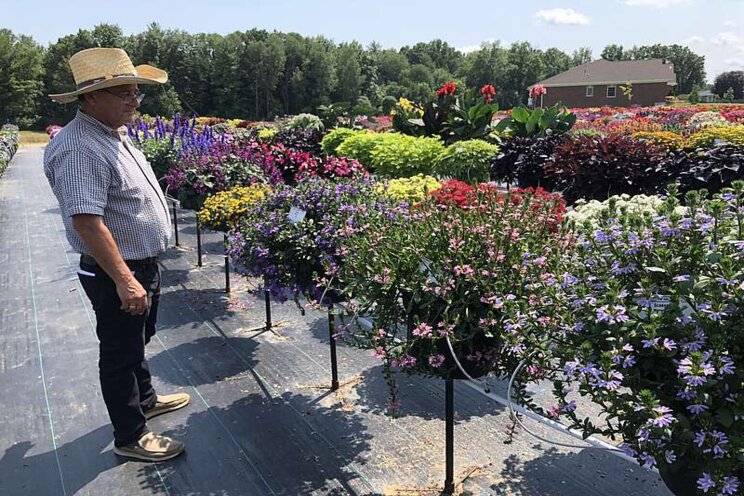A look at the Sawaya Gardens' new trial location
Added on 12 August 2021

Running from July 21 to 23, the open house put nearly 3,000 varieties on display at their new location in Waterford, Ont. Visiting growers and garden centre retailers were able to catch the latest in breeding all in one place, keeping an eye out for unique plants and colours to add to their repertoire.
Upon arrival, visitors were greeted by two,12-ft show-stopping containers situated at the front of the lot, each filled with precisely 83 individual 14" pots of seven plants each, totally approximately 600 plants per hanger. Built with false bottoms, the planters were constructed by Simcoe, Ont.-based Ralph Smith Construction and DeCloet, who had a hand in his newly built 26,000 sq. ft. greenhouse, adjacent to nearly four acres of container trial grounds.
Along with the new location, organizer Melhem Sawaya also introduced new ways to evaluate the varieties.
A row of hangers were set up out front, featuring mixes created by different ornamental breeders. Visitors to the trial were asked to rank their favourites in first, second or third place. Sawaya also put in a new grading system for all of the varieties on display, evaluating each one multiple times throughout the growing season. The top scorers, along with the winners of the hanger displays, will be revealed in a future edition of Greenhouse Canada.
In the meantime, he shared some keen observations from this and previous years while touring the gardens.
More consumer attention needed
There are a good number of high-performing plants that do not sell nearly as well as they should at retail.
He points to the Angelonia and the Pentas as examples, which are often sold as single plants in the spring when they're skinny, naked and unattractive. By this time in July, they've undergone complete transformations into floriferous, voluminous entities.
Bracteantha is another one often overlooked by consumers for the same reason. By July, it's laden with sturdy, upright flowers that have an almost surreal synthetic perfection about them.
There is a need to show consumers how plants progress, says Sawaya. He suggests that it could be addressed at retail through photos and digital displays of the plants in full bloom in the garden.
Continuous flowering
Readers of Sawaya's previous trial coverage will note his appreciation of continuously flowering varieties.
Here he highlights a Sol D Oro, a Heliopsis variety that displays five stages of flowering. "the oldest ones and youngest ones still look good," he says.
He points to the Vista petunia and Double Priscilla as examples of ideal self-cleaning varieties. Within the perfectly mounded habit are faded flowers, hidden amid large, uniformly dispersed blooms.
Thriving in the heat
Even with temperatures ranging from high 20s to low 30s over the previous few weeks, the vast majority of plants were in tip-top shape. The usual heat-loving suspects were performing very well at the trials - lantana, phlox, pentas.
Contrary to some preconceived notions, the begonias were brimming with luscious blooms, even while sitting out in full sun.
Pests and biocontrols
Sawaya incorporated biocontrols this year.
Some of the thunbergia came in with broad mites, he says. To counter this problem, he applied cucumeris under the leaves, which seemed to have worked. He's done the same for the calibrachoa, which would otherwise be consumed by thrips in a few weeks.
Unfortunately, the Japanese Beetle found its way into some of the varieties outside.
Petunias
Some of the petunias had a hard time standing up to the rain.
As Sawaya points out, it's the petunias that grow upright and tend to branch, which makes them top-heavy and prone to splitting. Otherwise, others looked fabulous amid the trials grounds.
Perennials
Many of the perennials seemed to do quite well in the heat. The colder weather earlier in the season was able to drive larger blooms.
Among the Osteospermum, Sawaya notes how the newer genetics no longer rely on low temperatures to set buds.
Next year, he hopes to install perennial beds to trial some Zone 5 varieties for two to three consecutive years.
Click here for more information.
Source and Photo Courtesy of Greenhouse Canada
Source: Greenhouse Canada
More news















